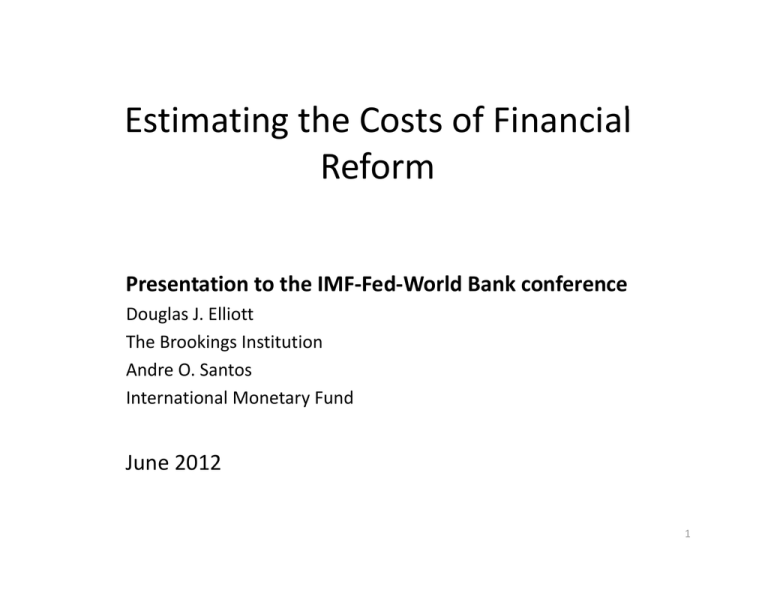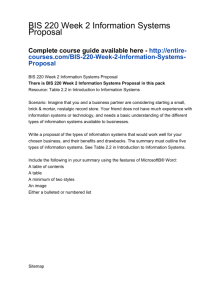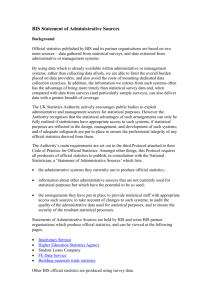E ti ti th C t fFi il Estimating the Costs of Financial Reform
advertisement

E ti ti th Estimating the C Costs t off Fi Financial i l Reform Presentation to the IMF-Fed-World Bank conference Douglas J. Elliott The Brookings Institution Andre O. Santos International Monetary Fund June 2012 1 Scope of the Project • Goal is to estimate the drag on the economy, during non-crisis years, from additional safety margins, such as higher capital requirements • No attempt is made to quantify the payoff in terms of reduced damage from financial crises • Focus is on long-term equilibrium. Transitional effects are reviewed only tangentially • Separate estimates are provided for three regions: US, Europe, Japan. Analysis of Japan is most tentative 2 Categories Chosen for Quantification • • • • • • Capital Liquidity Derivatives Securitization – data did not prove to be available Taxes The other categories were deemed to be both less important and and, often often, too hard to quantify 3 Loan Pricing Equation: Is L*(1-t) >= (E*re)+((D*rd)+C+A-O)*(1-t), where L = Effective interest rate on the loan, including the annualized effect of fees t = Marginal tax rate for the bank E = Proportion of equity backing the loan re = Required rate of return on the marginal equity D = Proportion of debt and deposits funding the loan, assumed to be the amount of the loan minus E Rd = Effective marginal interest rate on D, including indirect costs of raising funds, such as from running a branch network C = The credit spread, equal to the probability-weighted expected loss A = Administrative and other expenses p related to the loan O = Other income and expense Cumulative Impact of Regulatory Reforms on Credit Spreads (In Basis Points) Europe Japan U.S. Capital 19 13 40 Modigliani-Miller pass-through -9 -7 -20 Liquidity Coverage Ratio (LCR) 8 1 11 Net Stable Funding Ratio (NSFR) 10 11 16 Overlap of LCR and NSFR actions (half of smallest) -4 0 -5 Derivatives 1 N.A. 3 Taxes and fees 6 0 4 31 18 48 Expense cuts (at 5% for Europe, 10% for US) 8 8 15 Other aggregate adjustments 5 3 5 3 N.A. 2 Total adjustments 13 10 20 Net cost 18 8 28 Total gross effects of which: Mitigation 5 Sensitivity Analysis and Effects on Credit Spreads (In Basis Points) Europe Japan US U.S. 1 1 2 Base cost of other funding sources +1 percentage point -1 -1 -1 Modigliani-Miller pass-through +25 percentage point Required minimum common equity to RWA +1 percentage point -5 -3 -10 3 2 6 3 1 5 7 9 11 Base ROE required by investors +1 percentage point Marginal tax rate +10 percentage point Increase in pre-tax funding cost or reduction in investment income by 1 percentage point 6 Previous Findings Basel III impact Zone Impact on credit spreads Impact on annual GDP growth C Credit G GDP (bps) (%) (bps) (%) Europe Japan U.S. Europe Japan U.S. Global impact IIF 2012-2019 328 181 243 -0.40 -0.30 -0.10 281 -0.20 IIF 2011-2015 291 202 468 -0.60 -0.80 -0.60 364 -0.70 OECD 5 years transition 54 35 64 -0.23 -0.09 -0.12 53 -0.16 BIS Long-term (capital) 1/ 2/ 3/ 52 N.A. 52 -0.07 N.A. -0.03 52 -0.06 BIS Long-term (liquidity) 3/ 4/ 25 N.A. 25 -0.03 N.A. -0.03 25 -0.03 BIS Long-term Long term (combined) 3/ 5/ 66 NA N.A. 66 -0.08 0 08 NA N.A. -0.04 0 04 66 -0.08 0 08 1/ BIS estimates an increase in credit spread of 13 bps for each one point increase in the ratio of Tangible Common Equity to Risk-Weighted Assets, but does not estimate the total required change in that ratio. For broad consistency with the IIF and OECD figures, a 4 point change in the ratio is assumed. 2/ U.S. and European figures for needed capital increases are assumed to be the same for this table. 3/ BIS estimates the permanent permanent, steady steady-state state change in level of GDP GDP. For comparison with the other studies studies, the cost is spread over 8 years. 4/ BIS does not provide a breakdown by region on the credit spread effects of liquidity changes, so global figures are used for both regions. 5/ There are synergies between the capital and liquidity requirements, reducing the combined effects. 7 Conclusions • Financial a c a reform e o comes co es at a ap price, ce, in terms e s of o a drag d ag on o the economy during “normal” years • We did not make our own estimates of the benefits of financial reform, but the costs appear reasonable and to be smaller than the expected benefits • Banks B k have h a considerable id bl ability bilit tto adapt d t tto th the changes h without radical actions • There is a great deal of additional work that would be necessary to be sure of all these conclusions. Financial systems are complex and so are the reform measures 8


